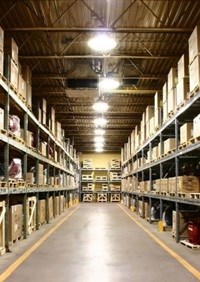In this article, Mark Mackay, regional manager of Zebra Technologies South Africa, discusses the challenges facing warehouses. He explains how the Internet of Things (IoT) offers the potential to enable new workflows to meet the demand for ever faster, ever more accurate fulfilment and discusses five steps to embrace 'always connected' technology.
There's a legacy view that the warehouse is a cost centre where the focus is on cutting costs by ironing out efficiencies. That perception is changing.

The main reason for this is that, in many markets - retail and manufacturing in particular - the faster fulfilment of orders, through any channel, is a clear competitive differentiator. As the focus shifts to redesigning the warehouse to meet the demand for next-day and same-day delivery, there are barriers to overcome.
One of the most important issues is the sheer size of today's warehouses. How can staff easily move around and find and pick stock in these sites? And how can they be trained faster? It can take at least 48 hours to get new people to full productivity - that's too long in such a fast-paced environment. Then there's the need to achieve maximum visibility - seeing every item, everywhere across the supply chain. This is essential if the warehouse is to fulfil its role as a 'command centre', coordinating the delivery and returns of orders through any channel - online, physical and mobile.
In addition, the volume of goods being processed means that automation is essential. We still come across some warehouses using paper to manage orders. This is no longer viable. What's more, legacy mobile computers may not be up to the job of enabling easy, high-volume picking. In many warehouses, technology will need to be refreshed to keep in time with changing business demands.
These are not insignificant challenges. But IoT promises to help overcome them.
Three trends are enabling IoT in the warehouse. First are high-performance wireless networks that provide an always-on connection to the back office. Second are smart sensors - such as RFID chips and GS-1 compliant barcodes - and location technology that makes it easier to automate the collection of item data, monitor the status of goods and find items. Third, the easier integration of previously separate back office systems simplifies data analysis to support better decisions and gain complete visibility over the stock position. The following five steps will help you take move to IoT:
1. Optimise your wireless network: With high and dense shelves and moving equipment and inventory, the warehouse is a demanding place for a wireless network to operate. Industrial-grade wireless networks can overcome these radio-frequency challenges. They provide the reliability, speed and capacity to manage thousands of simultaneous connections and high volumes of data - and even provide coverage in the cold store.
2. Power through picking: Smarter, connected devices are easing the process. The devices, which are more intuitive, adaptable and flexible, include body-worn options and ring scanners to keep hands free. They enable workflows to be streamlined by offering picking options that include voice instructions (and confirmations), pick-to-light (where a scan of a barcode illuminates lights above the picking bin to advise how many items to pick) and scanning (of barcodes and RFID chips). Advances in interface design ensure that devices are second nature to use to slash training time. They also provide a continuous stream of data about picking progress to update the stock position.
3. The sense in sensors: New location technology, such as Bluetooth beacons, connect over the wireless network to provide your teams with a precise location of goods. With your teams spending up to 70% of their time simply walking between aisles looking for goods, the technology can have a marked impact on productivity. People can be voice-guided to their picking location - or via a map on their handheld device - to find their items quickly and without getting lost. Sensors, such as smart RFID tags, can also be used to provide a stream of data on the status of goods, with back office systems raising alerts if a problem arises (e.g. a cold store rises above a certain temperature). This is especially helpful where you're storing perishable goods such as frozen food.
4. Connect the back office: Warehouse Management Systems (WMS), Transport Management Systems (TMS), Enterprise Resource Planning (ERP) and more - these applications are often not linked together. And to make the most of the streams of data being collected from the warehouse and beyond - through to delivery and returns - fully integrated warehouse management systems are needed to help you see stock status and track every item everywhere. New cloud-based technology provides the opportunity to deploy lower-cost WMS. The industry is moving in this direction with 68% of organisations planning to implement fully featured and fully integrated WMS by 2018.
5. Optimise outgoing and incoming goods: The use of automated RFID systems to automatically log pallets out - and in - to warehouses is becoming more commonplace. And, when linked to automated WMS systems and handheld devices that instruct teams for put-away, the technology can deliver huge time savings. However, one area of the warehouse that isn't so automated is the returns process and in the drive to see everything, everywhere, using barcodes and RFID chips to manage returns into the warehouse can help provide a more complete picture of the stock position across the supply chain.
IoT enables continuous connections between handheld devices, fixed RFID readers, sensors, and aisle and shelf beacons to support the integration of more automation in the warehouse. It can help teams be more productive, further streamline processes and deliver major workflow improvements in areas such as returns management. As the industry strives to achieve accurate fulfilment and ever-faster delivery - while managing larger warehouses, more people and more SKUs - moving towards an IoT strategy will become essential and provides the capability to turn the warehouse from a cost centre into business differentiator.